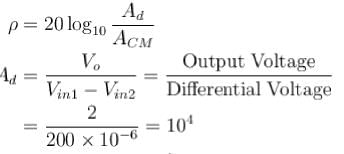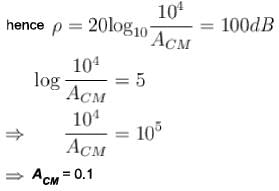Physics Exam > Physics Questions > The Common Mode Rejection Ratio (CMRR) of a d...
Start Learning for Free
The Common Mode Rejection Ratio (CMRR) of a differential amplifier using an operational amplifier is 100 dB. The output voltage for a differential input of is 2V. The common mode gain is (in dB)
Correct answer is '0.1'. Can you explain this answer?
Verified Answer
The Common Mode Rejection Ratio (CMRR) of a differential amplifier usi...

Where Ad = differential voltage gain
= large signal voltage gains

= Common mode voltage gain
The CMRR is generally expressed is dB and denoted by


The correct answer is: 0.1
Most Upvoted Answer
The Common Mode Rejection Ratio (CMRR) of a differential amplifier usi...
Common Mode Rejection Ratio (CMRR)
The Common Mode Rejection Ratio (CMRR) is a measure of how well a differential amplifier rejects common mode signals. It quantifies the ability of the amplifier to amplify the differential input signal while rejecting any common mode signal.
Given Information
- CMRR = 100 dB
- Output voltage for a differential input = 2V
Calculating Common Mode Gain
The common mode gain (ACM) is the ratio of the output voltage to the common mode input voltage. It is usually expressed in dB.
We know that CMRR = 20 log10 (ADM/ACM), where ADM is the differential mode gain.
Using the given CMRR value, we can rearrange the equation to find ACM.
CMRR = 20 log10 (ADM/ACM)
100 = 20 log10 (ADM/ACM)
5 = log10 (ADM/ACM)
ADM/ACM = 10^5
Since the common mode gain is usually very close to unity for an ideal differential amplifier, we can assume ACM to be 1.
ADM/1 = 10^5
ADM = 10^5
Converting to Linear Scale
The common mode gain (ACM) is usually expressed in dB. To find the common mode gain in linear scale, we need to convert it back from dB.
ADM = 10^(5/20)
ADM = 10^0.25
ADM = 1.78
Answer
The common mode gain (ACM) is approximately 1.78 in linear scale, which is equivalent to 0.1 dB. Therefore, the correct answer is 0.1 dB.
The Common Mode Rejection Ratio (CMRR) is a measure of how well a differential amplifier rejects common mode signals. It quantifies the ability of the amplifier to amplify the differential input signal while rejecting any common mode signal.
Given Information
- CMRR = 100 dB
- Output voltage for a differential input = 2V
Calculating Common Mode Gain
The common mode gain (ACM) is the ratio of the output voltage to the common mode input voltage. It is usually expressed in dB.
We know that CMRR = 20 log10 (ADM/ACM), where ADM is the differential mode gain.
Using the given CMRR value, we can rearrange the equation to find ACM.
CMRR = 20 log10 (ADM/ACM)
100 = 20 log10 (ADM/ACM)
5 = log10 (ADM/ACM)
ADM/ACM = 10^5
Since the common mode gain is usually very close to unity for an ideal differential amplifier, we can assume ACM to be 1.
ADM/1 = 10^5
ADM = 10^5
Converting to Linear Scale
The common mode gain (ACM) is usually expressed in dB. To find the common mode gain in linear scale, we need to convert it back from dB.
ADM = 10^(5/20)
ADM = 10^0.25
ADM = 1.78
Answer
The common mode gain (ACM) is approximately 1.78 in linear scale, which is equivalent to 0.1 dB. Therefore, the correct answer is 0.1 dB.

|
Explore Courses for Physics exam
|

|
Similar Physics Doubts
Question Description
The Common Mode Rejection Ratio (CMRR) of a differential amplifier using an operational amplifier is 100 dB. The output voltage for a differential input of is 2V. The common mode gain is (in dB)Correct answer is '0.1'. Can you explain this answer? for Physics 2025 is part of Physics preparation. The Question and answers have been prepared according to the Physics exam syllabus. Information about The Common Mode Rejection Ratio (CMRR) of a differential amplifier using an operational amplifier is 100 dB. The output voltage for a differential input of is 2V. The common mode gain is (in dB)Correct answer is '0.1'. Can you explain this answer? covers all topics & solutions for Physics 2025 Exam. Find important definitions, questions, meanings, examples, exercises and tests below for The Common Mode Rejection Ratio (CMRR) of a differential amplifier using an operational amplifier is 100 dB. The output voltage for a differential input of is 2V. The common mode gain is (in dB)Correct answer is '0.1'. Can you explain this answer?.
The Common Mode Rejection Ratio (CMRR) of a differential amplifier using an operational amplifier is 100 dB. The output voltage for a differential input of is 2V. The common mode gain is (in dB)Correct answer is '0.1'. Can you explain this answer? for Physics 2025 is part of Physics preparation. The Question and answers have been prepared according to the Physics exam syllabus. Information about The Common Mode Rejection Ratio (CMRR) of a differential amplifier using an operational amplifier is 100 dB. The output voltage for a differential input of is 2V. The common mode gain is (in dB)Correct answer is '0.1'. Can you explain this answer? covers all topics & solutions for Physics 2025 Exam. Find important definitions, questions, meanings, examples, exercises and tests below for The Common Mode Rejection Ratio (CMRR) of a differential amplifier using an operational amplifier is 100 dB. The output voltage for a differential input of is 2V. The common mode gain is (in dB)Correct answer is '0.1'. Can you explain this answer?.
Solutions for The Common Mode Rejection Ratio (CMRR) of a differential amplifier using an operational amplifier is 100 dB. The output voltage for a differential input of is 2V. The common mode gain is (in dB)Correct answer is '0.1'. Can you explain this answer? in English & in Hindi are available as part of our courses for Physics.
Download more important topics, notes, lectures and mock test series for Physics Exam by signing up for free.
Here you can find the meaning of The Common Mode Rejection Ratio (CMRR) of a differential amplifier using an operational amplifier is 100 dB. The output voltage for a differential input of is 2V. The common mode gain is (in dB)Correct answer is '0.1'. Can you explain this answer? defined & explained in the simplest way possible. Besides giving the explanation of
The Common Mode Rejection Ratio (CMRR) of a differential amplifier using an operational amplifier is 100 dB. The output voltage for a differential input of is 2V. The common mode gain is (in dB)Correct answer is '0.1'. Can you explain this answer?, a detailed solution for The Common Mode Rejection Ratio (CMRR) of a differential amplifier using an operational amplifier is 100 dB. The output voltage for a differential input of is 2V. The common mode gain is (in dB)Correct answer is '0.1'. Can you explain this answer? has been provided alongside types of The Common Mode Rejection Ratio (CMRR) of a differential amplifier using an operational amplifier is 100 dB. The output voltage for a differential input of is 2V. The common mode gain is (in dB)Correct answer is '0.1'. Can you explain this answer? theory, EduRev gives you an
ample number of questions to practice The Common Mode Rejection Ratio (CMRR) of a differential amplifier using an operational amplifier is 100 dB. The output voltage for a differential input of is 2V. The common mode gain is (in dB)Correct answer is '0.1'. Can you explain this answer? tests, examples and also practice Physics tests.

|
Explore Courses for Physics exam
|

|
Signup to solve all Doubts
Signup to see your scores go up within 7 days! Learn & Practice with 1000+ FREE Notes, Videos & Tests.















